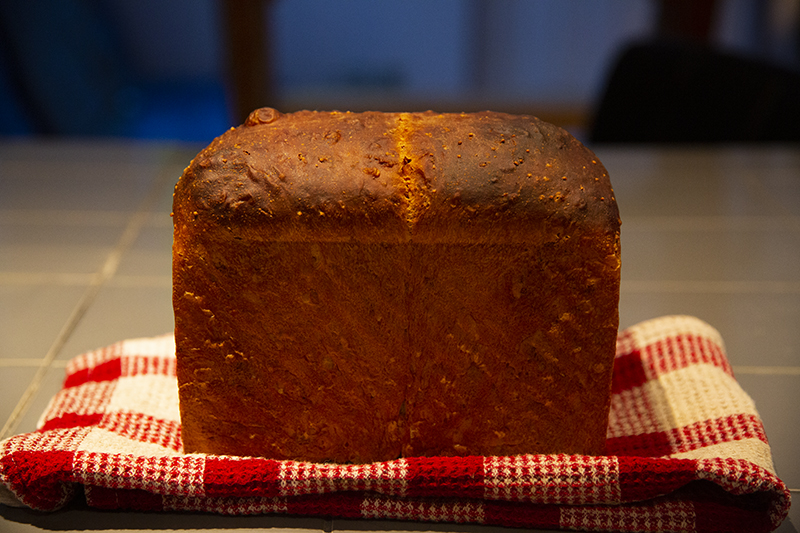
Maple Milk Bread...Delicious but a few mishaps

I made Maple Milk Bread using Eric Kim from NYT Cooking's recipe. The bread turned out really light, sweet and delicious, and it made my house smell so good. But I did have a few challenges, below, so I will definitely return to this bread and try my hand at making it again, hopefully with some more success.
In step 2, when you remove the tangzhong from the stovetop and add in the other ingredients, including cream and instant yeast, I think my cream was too cold and kept the yeast from activating completely. Once baked, there was some undissolved yeast on the outside of the bread. Next time, I will take the cream out of the fridge earlier so the dough isn’t too cold, inhibiting the yeast from doing its thing.
You can see the undissolved yeast on the exterior of the baked loaf
Also, despite the recipe saying that you should let the dough rise until it’s risen an inch above the rim of the loaf pan, I got nervous when it reached the lip that it would go too far, and put it in the oven too early. While my bread was still delicious, it didn’t have the cute mushroom shaped top that Eric describes as looking like an emoji of a loaf of bread. Next time I will be more patient…
Curious if anyone has tried this recipe or a similar one before and experienced my yeast mishap? Or if you have other milk bread recipes you like.
Thanks!
Hannah
(Creator of Good Book/Good Bread)



The loaf looks pretty good from the outside, despite the visible IDY. I actually prefer a more straight-sided loaf. How's the crumb?
The recipe is behind a paywall so I cannot see the instructions. Did you check the temperature of the mixture before adding the IDY? It may not have been too cold. It could have been that the yeast did not get mixed in well enough to dissolve in the dough. I have had some doughs that the yeast did not dissolve because the matrix was too dry and I couldn't/didn't mix enough. Other recipes, like Rreinhart's in Whole Grain Breads, where the IDY is routinely added at room temperature to a biga/soaker mix, were not a problem.
Oh whoops, didn't realize it was paywalled! Thanks for your suggestions. Below is the step in the recipe where I think things went wrong for me. I didn't check the mixture recipe beforehand, but I will note that for next time. The crumb was consistent and tight, but from the video of the recipe (on YouTube, here), that looks like what the recipe creator's loaf had too.
Make the bread: Remove the pot from the heat and whisk in the cream until smooth, which will cool down the mixture and add some necessary fat. To the creamy mixture, add 4 cups/576 grams bread flour, the maple syrup, egg, salt and yeast, and stir with a wooden spoon or rubber spatula until you can no longer see any streaks of egg or flour. Cover the pot with a lid and let sit in a warm place to proof and hydrate until doubled in size, 1 to 2 hours.
Try whisking the yeast into the flour or water first before combining all the ingredients. I also cannot read the recipe but I know cream is very fatty and if yeast was dropped into the cream it most likely coated the yeast so it could not dissolve properly.
Tip: After making and cooling a tangzhong, it should be wet enough to dissolve the yeast. If the tangzhong boils, it looses a lot of water quickly and cooked too long. It only has to thicken. I weigh the pot with the flour and water before cooking and then afterwards, replacing any evaporated water.
Ahh thank you, that is super helpful. My tangzhong was really thick, and definitely not wet enough for the yeast to dissolve in. I've pasted that step of the recipe below here, but I will try your suggestions next time.
Make the bread: Remove the pot from the heat and whisk in the cream until smooth, which will cool down the mixture and add some necessary fat. To the creamy mixture, add 4 cups/576 grams bread flour, the maple syrup, egg, salt and yeast, and stir with a wooden spoon or rubber spatula until you can no longer see any streaks of egg or flour. Cover the pot with a lid and let sit in a warm place to proof and hydrate until doubled in size, 1 to 2 hours.
It's also possible that the TZ lost a fair amount of liquid during heating and cooling. When I've used TZ in a recipe, I weigh the container before and after heating and add back liquid to compensate for any weight loss. I think MiniOven is also an advocate of this compensation.